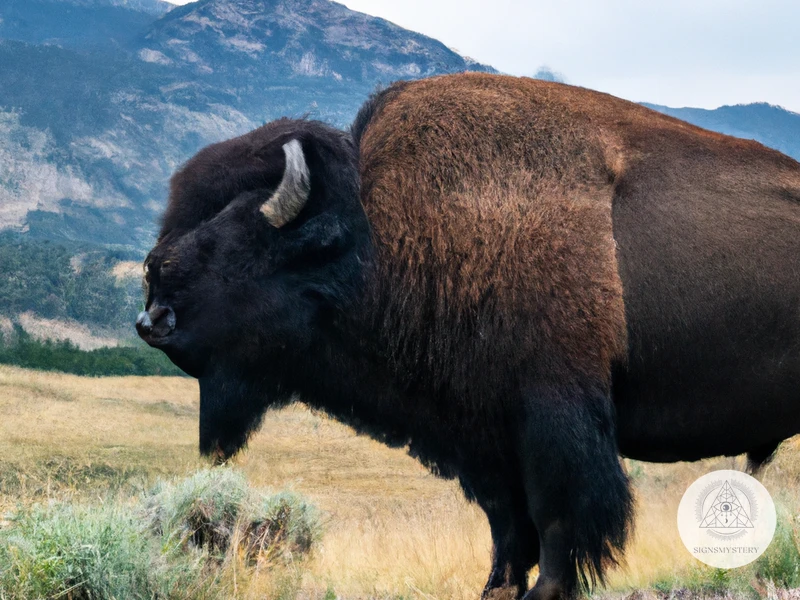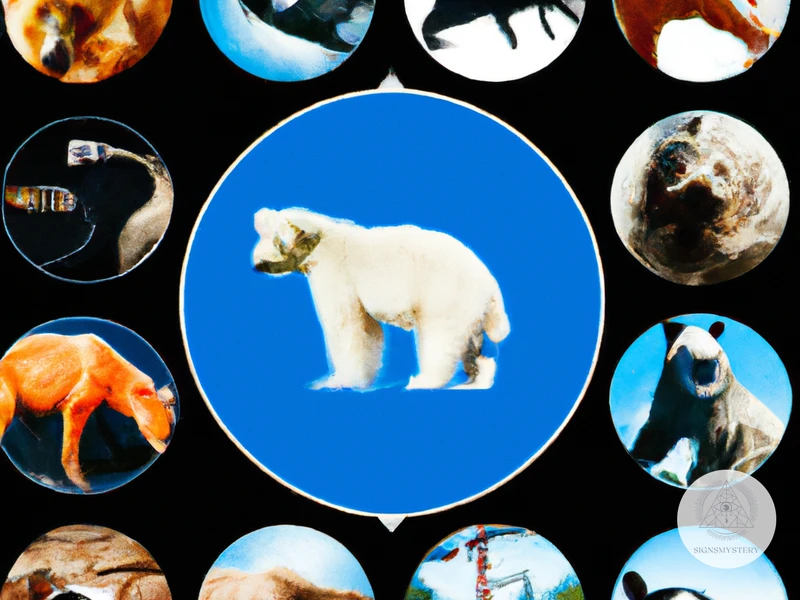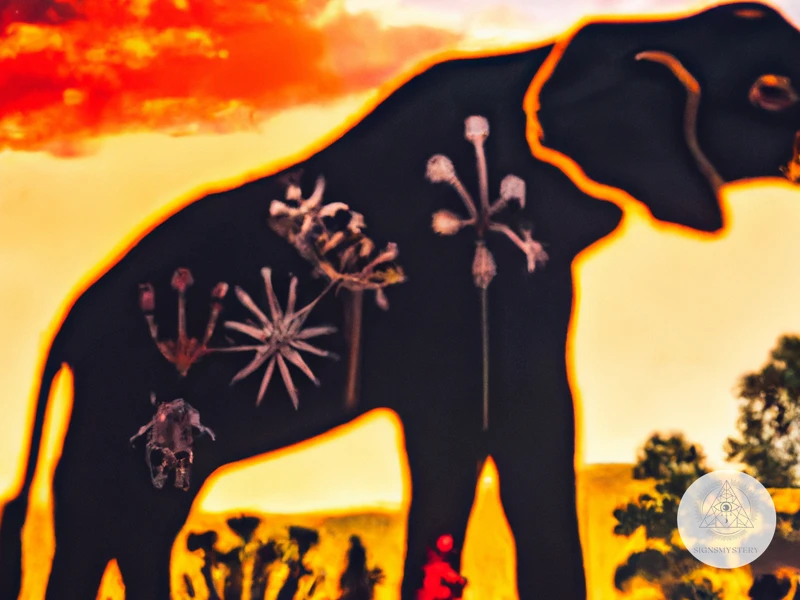The significance of national symbols varies from country to country, but one common feature amongst them is the endorsement of national pride and identity. Among these symbols, national mammals play a pivotal role in representing a country’s cultural heritage, values, and identity. The creatures range from predators to herbivores, each of which holds particular meaning for its country. In this article, we will dive into a world tour and explore national mammal symbols of different countries and discuss how they reflect the countries’ culture and beliefs. Additionally, we will look into the controversies that surround these symbols and the role they play in conservation and international relations.
What is a National Mammal Symbol?

A National Mammal Symbol is a representative animal of a country chosen to symbolize its culture and heritage. This symbol is usually a native mammalian species with significant historical, cultural, or ecological importance. Different countries have their criteria for selecting the National Mammal Symbol. For example, the Russian brown bear symbolizes the country’s strength and resilience. The biggest criterion for the USA’s bison was its significant historical and cultural importance in shaping the country’s past. The significance of these symbols is closely tied to the countries’ culture and identity and reflects their love for nature and wildlife. Other countries also have their national symbols that represent something close to their hearts, such as the North American Beaver for Canada and the Kangaroo for Australia.
A Brief History
The concept of having a national animal symbol dates back to ancient times when tribal societies had their own sacred animal or totem that represented their spiritual beliefs. As societies evolved into nations, they adopted animals as symbols to represent their identity and values. In fact, some of the earliest known national animal symbols date back to the ancient civilizations of Egypt, Persia, and Greece.
In modern times, the concept of a national mammal symbol has gained significant importance, particularly in countries that have undergone major social and economic changes. The selection of a national mammal symbol has become a way for a country to showcase its cultural heritage and natural diversity.
In the United States, for example, the adoption of the Bison as the national mammal symbol in May 2016 was a historic event that marked the end of a long battle to recognize a species that had once been on the brink of extinction. According to the history of national emblems in the US, the tradition of having national symbols dates back to the founding of the country, and the Bison was chosen as a symbol of resilience and strength.
Similarly, in countries like Australia and Canada, the adoption of national mammal symbols like the Kangaroo and the North American Beaver respectively, reflects a deep connection to their natural landscapes and unique wildlife.
The history of national mammal symbols is a complex and evolving one that reflects the changing cultural and environmental needs of society. From its early origins as a spiritual totem to its modern-day role as a symbol of national pride and conservation, the importance of this tradition is something that will continue to be celebrated in the years to come.
Criteria for Selection
The criteria for selecting a National Mammal Symbol differ from country to country. In most cases, the selected mammal represents an important aspect of the country’s history, culture, or environment. For example, in India, the Bengal tiger is the National Mammal Symbol because of its cultural significance and its role as a predator that keeps the ecological balance in check. Similarly, in Russia, the brown bear represents the strength and power of the country and is revered in folklore.
In the United States, the bison was declared the National Mammal Symbol in 2016, becoming the first national mammal of the country. The selection of the bison was based on its cultural and historical significance to Native American tribes and its role as an important symbol of the American West. The bison was also chosen for its ecological importance as a keystone species that plays a crucial role in maintaining the ecosystem in the Great Plains region.
In some countries, the selection of National Mammal Symbols is also based on the need for conservation efforts. The designation of a specific animal as the National Mammal Symbol can help raise awareness about its conservation needs and stimulate public support for their preservation.
The criteria for selecting a National Mammal Symbol are diverse and complex, often reflecting the unique history, culture, and environment of the country. The selection process involves taking into consideration the animal’s cultural and historical significance, ecological importance, and conservation needs. By understanding the criteria for selecting a National Mammal Symbol, we can gain a deeper appreciation for the role these animals play in the nation’s identity and heritage.
National Mammal Symbols Around the World
National Mammal Symbols are an important part of a country’s identity and culture, representing the richness of its flora and fauna. India’s Bengal Tiger is the national animal since 1972 and is depicted in many cultural traditions. Russia’s Brown Bear is a symbol of strength and courage while Canada’s North American Beaver is a symbol of hard work and industriousness, introduced as a national emblem in 1975. The USA’s National Mammal Symbol is the bison, which is symbolic of American westward expansion and is revered by Native American culture. Similarly, Australia’s Kangaroo has cultural and traditional significance and is considered a symbol of freedom and agility. Similarly, different animals are chosen as national symbols of countries based on their cultural significance, the animal’s role in the country’s history, and the values it embodies.
India: Bengal Tiger
India has designated the Bengal Tiger as its national mammal, a decision that reflects India’s deeply held cultural admiration for the animal’s prowess as a hunter and power as a symbol. The Bengal Tiger is the apex predator of the Indian subcontinent and can weigh up to 600 pounds. The animal’s distinctive striped coat has made it a popular artistic motif throughout India’s history, from cave paintings to sculptures to the contemporary national emblem.
However, despite India’s reverence for the Bengal Tiger, the animal has come under threat in recent years due to habitat loss and poaching. India has taken steps to counteract these threats through conservation efforts, such as the creation of protected areas like the Sundarbans in West Bengal and the Sariska Tiger Reserve in Rajasthan. These efforts have not only helped save the Bengal Tiger population, but have also brought attention to the larger issues of conservation and preservation in India.
The Bengal Tiger’s status as India’s national mammal has also had political significance, as it has been used as a symbol of Indian identity and pride. This has been especially apparent on the international stage, for example in India’s rejection of the United States’ proposal to designate the Bald Eagle as the national bird of the world, citing the Bengal Tiger’s significance as a representation of India’s natural heritage.
The Bengal Tiger holds great significance for India as a powerful cultural symbol and a reminder of the importance of conservation and preservation efforts.
Russia: Brown Bear
In Russia, the brown bear serves as the national mammal symbol. The brown bear is highly respected and revered in Russian culture and mythology. It is a symbol of strength, courage, and resurrection. It is also believed to have healing powers. According to Russian beliefs, killing a brown bear brings bad luck and misfortune.
The brown bear’s significance in Russian society can be traced back to ancient times. It was seen as a deity and was worshiped by ancient tribes who believed they were descendants of the bear. They would hold feasts in honor of the bear and wear bear skins to channel their inner strength.
Today, the brown bear continues to be a vital part of Russian culture. It appears prominently in Russian literature, music, and art, serving as a symbol of the country and its people. The brown bear is even depicted on the coat of arms of several Russian cities.
The brown bear’s conservation in Russia has played a significant role in its national symbol status. Brown bears in Russia are protected by law, and the country is home to the largest population of brown bears in the world. Russian efforts to conserve brown bears signify their cultural and environmental significance, linking the brown bear to the country’s natural heritage.
The brown bear represents the strength, natural heritage, and cultural significance of Russia. Its symbolism in Russian culture shows the deep connection Russians have with their natural environment and its wildlife, and the importance of conservation efforts for the country’s national mammal symbol.
USA: Bison
The bison has been designated as the national mammal of the United States, representing an animal that is deeply ingrained in the country’s history and culture. Native American tribes consider the bison as a sacred animal and rely on their existence for spiritual and cultural practices. European settlers also recognized the animal’s economic value, leading to the expansion of the bison population during the 19th century.
However, the uncontrolled hunting of bison almost led to their extinction, with just a few hundred remaining by the early 20th century. The situation improved with the establishment of the American Bison Society in 1905. Also, President Theodore Roosevelt played an essential role in developing policies to conserve the bison, leading to the creation of the National Bison Range in Montana in 1908. Today, a sustainable population of bison can be found in national parks, reserves and on private ranches across the United States.
The bison is a symbol of the American West, representing strength, resilience and freedom. The United States Department of the Interior, in its announcement of the national mammal designation, underscored that the bison’s history is also tied to America’s cultural and economic heritage. The proclamation acknowledged the significant role that bison played in Native Americans’ lives and the animal’s contribution to American art, literature and cuisine.
The bison serves as a significant emblem of the United States as it embodies the nation’s past and represents the country’s efforts in conserving its natural resources. Its significance is undeniable and has captured the heart of Americans and the world.
Want to learn more about the symbolism and history of national emblems? Check out our article on the history of the US national emblem.
Australia: Kangaroo
Australia has a unique and iconic national mammal symbol, the kangaroo. Kangaroos are marsupials, which means they carry their young in a pouch, and they are native to Australia. Australia is home to four different species of kangaroos, including the Red Kangaroo, Eastern Grey Kangaroo, Western Grey Kangaroo, and the Antilopine Kangaroo.
The kangaroo has cultural significance for the Indigenous Australians who have lived on the continent for tens of thousands of years. The kangaroo is an important animal in their mythology and a source of food and clothing. Today, the kangaroo is a popular symbol used in Australian culture for marketing, branding, and sports teams.
The kangaroo is also the emblem on the Australian national coat of arms, which depicts a kangaroo and an emu holding up a shield with symbols representing Australia’s states and territories. The kangaroo symbolizes progress and Australia’s forward-thinking attitude, while the emu represents resilience and determination.
Kangaroos are considered a national treasure in Australia, but they are also a controversial topic. Some farmers view kangaroos as pests that damage their crops and compete with their livestock for resources. Others argue that hunting and culling kangaroos is inhumane and that they should be protected in the wild.
Despite the controversies, the kangaroo remains an enduring symbol of Australia’s unique culture and environment. It represents the resilience and determination of the Australian people and their commitment to preserving their national treasures.
Internal link: To learn more about the significance of national tree symbols, check out our article on Significance of National Tree Symbols in Culture and Environment.
Canada: North American Beaver
The North American Beaver is the National Mammal Symbol of Canada. This large, semi-aquatic rodent is native to the country and is an important part of Canadian culture and history. Let’s take a closer look at why the beaver was chosen as Canada’s National Mammal Symbol.
Appearance and Habitat: Beavers are known for their flat, paddle-shaped tails and large, sharp front teeth. They can grow up to 4 feet long and can weigh up to 70 pounds. Beavers are found throughout the country, but prefer to live near bodies of water such as rivers, lakes, and ponds.
Historical Significance: The beaver played an important role in Canada’s early history. The fur trade, which was dominated by beaver pelts, was once a major part of the country’s economy. The beaver even appears on the Canadian nickel, showing its importance to the country.
Criteria for Selection: The selection of the North American Beaver as Canada’s National Mammal Symbol was based on several factors. Firstly, the beaver is native to Canada and has played an important role in the country’s history. Additionally, the beaver is a symbol of industriousness and perseverance, qualities that Canadians value.
Conservation Efforts: The beaver is an important part of Canada’s ecosystem, and conservation efforts have been made to protect the animal and its habitat. Beavers create wetlands, which provide habitats for a variety of other species.
Controversies: There have been controversies surrounding the use of the beaver as a National Mammal Symbol. Some animal rights activists argue that using an animal as a symbol is exploitative and objectifying. Others argue that the beaver’s historical significance to the fur trade is a problematic legacy.
The North American Beaver is an important and complex symbol for Canada. Its historical significance is intertwined with the country’s economy and identity, and its conservation status is a reminder of the importance of preserving Canada’s natural resources. The selection of the beaver as the National Mammal Symbol of Canada is a reflection of the animal’s unique place in Canadian culture and history.
Mexico: Xoloitzcuintli Dog
Mexico has a rich cultural history, and the selection of Xoloitzcuintli Dog as the official national animal symbol is steeped in that history. Also known as the Mexican Hairless Dog, the Xoloitzcuintli Dog has been an integral part of Mexican culture for over 3,000 years. The Aztecs believed that this breed of dog had healing properties and hence, considered it sacred. Legends say that after death, the Xoloitzcuintli would guide the souls of those passed through the afterlife.
Today, the Xoloitzcuintli Dog is recognized as a symbol of protection, loyalty and companionship in Mexican culture. In 2019, it was named the National Mammal Symbol of Mexico, making it the official representative of the country’s wildlife. This move has linked this ancient breed of dog with Mexico’s modern identity and helped preserve its role in the country’s cultural history.
The Xoloitzcuintli Dog has also become popular worldwide, with the breed recognized by the American Kennel Club since 1887. Despite its popularity, however, it is still facing a decline in its native country, with efforts being made to protect its existence. By selecting the Xoloitzcuintli Dog as the national mammal symbol, Mexico aims to not only celebrate the breed but also conserve it.
The selection of the Xoloitzcuintli Dog as the national mammal symbol of Mexico represents the country’s rich cultural heritage and its modern-day national identity. It also highlights the need to protect this ancient breed in its native land, ensuring that its legacy lives on for generations to come.
South Africa: Springbok Antelope
One of the most recognized symbols of South Africa is the Springbok Antelope. It is a medium-sized antelope and can be seen in large numbers across the South African plains and savannas.
In South Africa, the Springbok Antelope is not only considered a symbol of the country but is also the national animal. The animal’s speed and agility are what make it an important symbol of South Africa. The Springbok Antelope has the ability to leap up to three meters in the air and can run at speeds of up to 90 kilometers per hour. Its speed is a representation of the country’s progress.
The Springbok Antelope is also depicted on the South African national rugby team’s jersey, known as the Springboks. It has become a patriotic symbol, signifying unity and strength among all South Africans, and has played a crucial role in unifying the country after the dismantlement of apartheid.
Interestingly, there have been debates around whether the Springbok Antelope should continue to be used as a symbol, as some feel it represents the country’s colonial past and exclusionary politics. However, others argue that the animal holds cultural significance and is an integral part of South Africa’s identity.
The Springbok Antelope is a significant national symbol in South Africa that represents the country’s speed, agility, and progress. It is a symbol of unity and strength, and it continues to play a vital role in the country’s post-apartheid era.
Norway: Eurasian Elk
Norway’s national mammal symbol is the Eurasian Elk, also known as the Moose. The Eurasian Elk is the largest species of the deer family, and is found in forests all over Norway, making it a natural choice for a national symbol. The selection of the Eurasian Elk as Norway’s national mammal is also influenced by the animal’s traits. Its strength, stamina, and endurance make it an excellent representation of Norway’s natural resources and the Norwegian way of life.
In Norway, the Eurasian Elk is held in high regard and is a popular animal for hunting. It is also featured in many folk tales and myths. The Eurasian Elk has a special place in Norwegian culture and history, and its image can be seen on many different items, including coins, stamps, and the national coat of arms.
Norway’s national coat of arms features the Eurasian Elk, along with a lion and a crown. The design of the coat of arms dates back to the Middle Ages and has evolved over time, with the addition of the Eurasian Elk and other elements.
The choice of the Eurasian Elk as a national symbol is not without controversy, however. Some animal rights activists have criticized the use of the animal in hunting and as a symbol. They argue that the Eurasian Elk should be protected and not used as a trophy. Additionally, some people claim that the use of the Eurasian Elk as a national symbol is a form of cultural appropriation, as it is a significant animal in the traditions of the indigenous Sami people of Norway.
Despite the controversies, the Eurasian Elk remains an important national symbol in Norway, representing the country’s natural beauty, resources, and traditions.
Uses of National Mammal Symbols

National Mammal Symbols are used for various purposes, from patriotic symbols to conservation efforts. In many countries, the national coat of arms includes a national mammal symbol, representing the country’s heritage and cultural values. The national mammal symbol is often used to promote conservation and raise awareness of endangered species.
Subscribe to Our Newsletter
Sign up to receive the latest news and updates.
Patriotic Symbols
National mammal symbols are often used as patriotic symbols, representing the strength, resilience, and spirit of a country and its people. In many countries, these animals are deeply intertwined with national identity and history.
For example, in the United States, the bison has been an iconic symbol of the country’s frontier past and the power of the American West. It was so central to Native American culture and the livelihoods of early settlers that it was almost driven to extinction. The selection of the bison as the national mammal symbol in the US was seen as a way to honor the animal’s survival and resilience, as well as the role it played in shaping the country’s history.
Similarly, in South Africa, the springbok antelope has long been associated with the country’s national rugby team, the Springboks. The team’s name and logo feature the animal, and fans often wear shirts adorned with its image. The choice to use the springbok as a symbol of national pride and sporting spirit is a nod to the animal’s speed, agility, and grace, as well as its status as a beloved and iconic native species.
In other countries, national mammal symbols are used to celebrate the beauty and diversity of the natural world, and to promote conservation efforts. The Eurasian elk, for example, is Norway’s national mammal symbol, representing the country’s vast forests and wild landscapes. The selection was made not only for the animal’s cultural significance, but also as a way to draw attention to the importance of protecting Norway’s natural heritage for future generations.
National mammal symbols serve as potent reminders of a country’s history, culture, and natural beauty, and are often used to inspire pride, loyalty, and a sense of collective identity among citizens.
Conservation Efforts
National mammal symbols play a significant role in conservation efforts, as they represent unique and endangered species. Governments and organizations often use these symbols as a means of promoting awareness for the need of conservation and environmental protection efforts. For instance, the national animal of India is the Bengal tiger, which has been declared an endangered species, and the Indian government has taken various measures to protect and conserve the species. The government has set up various tiger reserves, enacted laws to protect the species from poaching, and actively promotes ecotourism as an alternative source of income to local communities.
Similarly, the national mammal symbol of Russia, the brown bear, is also protected under the Russian law, with hunting only permitted under strict regulations. In the United States, where the bison is the national mammal symbol, the species was once on the brink of extinction. However, with continuous conservation efforts, the population has increased substantially in recent years, and the species is now considered as a conservation success story.
These symbols are often used as a tool to raise funds for conservation efforts. For instance, Australia’s national mammal symbol, the kangaroo, is a popular symbol for fundraising campaigns by various organizations that work to protect the species from hunters and habitat destruction. The North American beaver, the national mammal symbol of Canada, has also gained significance for the country’s conservation efforts, with conservation organizations promoting the use of the beaver as a symbol for environmental protection.
National mammal symbols have become important figureheads for the promotion of conservation efforts and environmental protection campaigns. Their significance, combined with the need for conservation, has made them a valuable tool in the fight against extinction and habitat destruction. It is vital to recognize the importance of these symbols as they play a crucial role in preserving the natural world for future generations to come.
International Relations
When it comes to international relations, national mammal symbols can also play a role. These symbols can be used to promote cultural exchanges between countries, or as a diplomatic tool to improve relationships. For example, the United States gave a bison to Russia in 1997 as part of a program to improve relations between the two countries. The gesture was well-received, and the bison, named “Bill” by the Russian people, became a symbol of goodwill between the two nations.
On the other hand, the use of national mammal symbols can also cause tensions between nations. For instance, China refused to loan two pandas to the United States in 1981, which strained the diplomatic relationship between the two countries. Similarly, the use of national mammal symbols can sometimes be interpreted as cultural appropriation, especially if the symbols are used in a disrespectful or insensitive manner.
Despite the potential for controversy, the use of national mammal symbols in international relations continues to be a popular way to promote diplomacy and exchange between nations. It is just one of the many ways in which animals play a significant role in cultures around the world.
Learn more about the significance of National Flower Symbols in different countries
Controversies Surrounding National Mammal Symbols
National mammal symbols are not necessarily accepted or appreciated by everyone. There are several controversies surrounding these symbols. One of them is related to animal rights activism. Some people believe that it is unethical to use animals as national symbols because it promotes speciesism and objectifies them. Another controversy is the cultural appropriation of some national mammal symbols. For example, many Native Americans feel that the bison, which is the national mammal symbol of the United States, has been taken away from them and used as a symbol of American patriotism. This has caused an ongoing dispute between Native American communities and the US government. Finally, political controversies can also arise from the use of national mammal symbols. Some political groups might use them to promote their own agendas, or use them as a way of showing superiority over other countries. National mammal symbols may represent different things to different people, and these controversies highlight their complex role in society.
Animal Rights Activism
National Mammal Symbols are often the subject of controversy when it comes to animal rights activism. Many activists believe that the use of animals as national symbols promotes the exploitation and commercialization of wildlife. They argue that by associating a species with a country’s national identity, it becomes a target for trophy hunting and other harmful practices.
Examples of Animal Rights Activism
One notable example is the controversy surrounding the use of the American Bison as the national mammal symbol of the United States. Animal rights groups argue that despite the bison’s designation as a national symbol, the species is still vulnerable to population declines due to hunting and habitat loss. Conservation efforts have been implemented, but many activists believe they are not enough.
Another example is the use of the Kangaroo as the national mammal symbol of Australia. Animal rights groups have been critical of the commercial kangaroo industry, which involves the hunting of kangaroos for meat and leather. Critics argue that the industry is inhumane and unsustainable, and that the use of kangaroos as a national symbol only serves to promote the exploitation of these animals.
Counterarguments
While animal rights activists raise valid concerns about the use of animals as national symbols, there are also counterarguments to consider. For example, some argue that the use of national symbols can actually promote conservation efforts. By raising awareness of a species and highlighting its importance to a particular country, national symbols can encourage public support for conservation efforts and habitat protection.
It is also worth noting that the selection of a national mammal symbol is often based on factors beyond just the animal’s commercial or utilitarian value. In many cases, the selection is based on cultural and symbolism significance, or on the animal’s historical or ecological importance to the country in question.
In any case, animal rights activism plays an important role in shaping public attitudes towards the use of animals as national symbols. As nations look to balance the need for conservation with their national identities, it is important to consider the perspectives and concerns of animal welfare advocates.
Internal link: National Bird Symbolism Evolution
Cultural Appropriation
Cultural appropriation refers to the practice of taking elements from one culture and using them in another culture without proper understanding or acknowledgement. Many people believe that using National Mammal Symbols as mascots or logos for sports teams or businesses can be a form of cultural appropriation, especially when it is done without considering the cultural significance of the symbol.
For example, in the United States, several sports teams have used the image of the bison, which is the National Mammal Symbol, as their logo. While the bison has a long history of cultural significance to Indigenous peoples in North America, these teams have used the symbol purely for commercial purposes, without acknowledging the cultural heritage behind it. This has led to controversy and calls for these teams to change their logos.
Similarly, the use of National Mammal Symbols in fashion or art without proper understanding or acknowledgement can be seen as a form of cultural appropriation. For instance, using the image of the Bengal tiger, which is India’s National Mammal Symbol, as a print on clothing or accessories without understanding its cultural significance or seeking proper permission from the Indian government can be seen as disrespectful.
It is important to be mindful of the cultural significance behind National Mammal Symbols and to use them with respect and understanding. Failure to do so can be seen as a form of cultural appropriation, which can be hurtful and disrespectful to the communities who hold these symbols in high regard.
Internal Link: To learn more about the factors behind the selection of National Aquatic Symbols, check out our article here.
Political Controversies
National mammal symbols can become a political hot potato, with controversies surrounding their use and selection process. One of the main sources of political controversy is the question of whether the chosen animal is politically correct or not. For instance, the selection of the American Bison as the US national mammal symbol received backlash from animal rights activists and indigenous leaders because of the animal’s controversial history.
Another controversy is the unequal representation of different animal groups in the selection process. For example, mammals like wolves, jaguars, and mountain lions, which are often considered controversial, are usually left out of the selection criteria. This has caused dissatisfaction among some conservationists who believe that these animals deserve recognition as national symbols.
There are cases where the selection of a national mammal symbol becomes a politically-driven process. For example, some countries may choose a particular animal with a connection to their political history or ruling party. This can lead to controversies among different groups with varying political ideologies.
In some cases, national mammal symbols have also been used for political agenda. For instance, the Australian government’s decision to cull kangaroos was met with international criticism, as the kangaroo is the country’s national mammal symbol. Similarly, in Russia, the brown bear is often used as a symbol of the country’s military might, which has caused controversies among international political circles.
National mammal symbols are not immune to political controversies, and their selection and use can often become a heated topic for debate. When choosing a national mammal symbol, it is important to consider the potential political implications and to ensure that the decision-making process is transparent and unbiased.
Anchor text: To learn more about the significance of national symbols, read our article on national currency symbols and national colors.
Conclusion
The significance of the National Mammal Symbol varies from country to country. It is a testament to the cultural, historical, and biological diversity of our planet. These symbols remind us of the importance of preserving our wildlife, not only for their aesthetic value but also for their ecological benefits. They serve as powerful tools for promoting patriotism, conservation efforts, and international relations.
However, controversies surrounding these symbols cannot be ignored. Animal rights activism, cultural appropriation, and political controversies have all stirred debates about the use of National Mammal Symbols.
Despite the challenges, National Mammal Symbols remain an essential aspect of our culture and identity. They inspire us to protect nature and preserve our heritage. As we move forward, we should strive to promote responsible conservation efforts and respectful cultural exchange.
In conclusion, the National Mammal Symbols continue to be an important part of our world’s heritage, and we should cherish and celebrate them for years to come. By doing so, we will be able to appreciate the beauty of wildlife, and preserve it for future generations.
Frequently Asked Questions
What exactly is a National Mammal Symbol?
A National Mammal Symbol is a mammal that has been officially designated by a country’s government to represent national identity, cultural heritage, and values.
How are National Mammal Symbols selected?
The selection process varies from country to country, but generally involves criteria such as cultural significance, historical relevance, ecological importance, and uniqueness.
Why do countries use National Mammal Symbols?
Countries use National Mammal Symbols to promote patriotism, conservation efforts, tourism, and cultural diplomacy.
What is the significance of the Bengal Tiger as India’s National Mammal Symbol?
The Bengal Tiger is a symbol of power, strength, and courage in Indian culture and mythology. It also represents India’s rich biodiversity, as the country is home to more than half of the world’s tigers.
What does the Brown Bear represent as Russia’s National Mammal Symbol?
The Brown Bear is an iconic symbol of Russian wilderness and tradition. It is also a symbol of strength and protection, and represents the importance of wildlife conservation in Russia.
Why is the Bison significant as the National Mammal Symbol of the USA?
The Bison, also known as the American Buffalo, represents the country’s frontier history, conservation efforts, and cultural heritage. It is also a symbol of strength, resilience, and freedom.
What does the Kangaroo represent as Australia’s National Mammal Symbol?
The Kangaroo is a unique and iconic symbol of Australia’s wildlife and culture. It represents the country’s adventurous spirit, resilience, and ability to adapt to changing environments.
How does the North American Beaver represent Canada as its National Mammal Symbol?
The North American Beaver is a symbol of Canada’s wilderness, industriousness, and ingenuity. It also represents the country’s strong connection to its natural resources and the importance of conservation efforts.
What is the Xoloitzcuintli Dog’s significance as Mexico’s National Mammal Symbol?
The Xoloitzcuintli Dog is a symbol of ancient Mexican civilization and culture. It is also believed to have healing and spiritual properties, and is used in traditional rituals and ceremonies.
Why is the Springbok Antelope South Africa’s National Mammal Symbol?
The Springbok Antelope is a symbol of freedom, vitality, and resilience in South African culture. It also represents the country’s rich wildlife, diverse landscapes, and cultural heritage.
What controversies have arisen around National Mammal Symbols?
Controversies include animal rights activism, cultural appropriation, and political debates over the selection and use of National Mammal Symbols.










